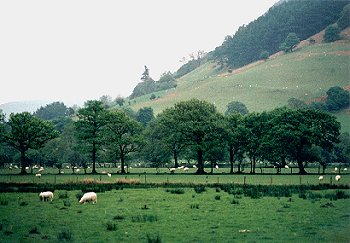
Cymraeg / English

|
Tanat Valley Historic Landscape |

|
Character area map |
Historic Landscape Characterisation
The Tanat Valley:
Glanhafon, Llangynog, Powys
(HLCA 1024)
Narrow tract of low-lying, valley-bottom meadow and marsh towards the eastern end of Dyffryn Tanat

Historic background
The area falls within the medieval ecclesiastical parishes of Pennant Melangell, Llangynog and Llanrhaeadr-ym-mochnant, and also falls within the area of the ancient commote of Mochnant Uwch Rhaeadr, Montgomeryshire.
Key historic landscape characteristics
Narrow tract of generally flat, low-lying, valley-bottom meadow between 0.3-0.5km across, between about 120-50m OD together with a narrow strip of sloping ground on the southern slopes of Cyrniau which carry up to a height of about 250m OD. The area includes the course of Afon Tanat and cut-off loops, with confluences of several streams including the Hirnant at Penybontfawr and the Afon Rhaeadr at Aber Rhaeadr. A number of the streams joining the river, such as the Nant Sebon to the east of Llangynog, are slightly raised and are embanked with boulders where they cross the valley bottom. Glanhafon-fawr being sited on the brink of a deep river scarp eroding through glacial deposits on the floor of the valley.
Settlement included within the character area includes the riverside farms and a number of other smaller farms on the southern slopes of Cyrniau. Late 18th- to early 19th-century stone farmhouses and outbuildings at Glanhafon-fawr, Glanhafon-ucha and Nant-y-wern.
There are extensive networks of drainage ditches in the waterlogged areas towards the western end of the area, some lined with mature willow and coppiced alder, representing overgrown hedged boundaries, the ditches and hedges possibly representing 18th-century or earlier improvement and enclosure of former common meadow. Low-cut generally single-species (hawthorn) hedges elsewhere, though there are a number of boundaries with drystone walls just to the east of Llangynog where surface stone was more readily available. In some instances several former fields have been run into one, hedges having become overgrown or reduced to intermittent lines of trees and shrubs. Occasional traces of ridging to improve drainage. Small sloping fields on the higher ground to the south, some with low-cut and some with overgrown multiple-species hedges including maple, oak, ash and hazel, with low banks and some lynchets on more steeply sloping ground. Remnant semi-natural woodland on steeper slopes.
The line of the dismantled Tanat Valley Light railway cuts a distinctive course along the floor of the valley, on the northern side of the river, running partly in a cutting but largely on a slight embankment.
Parkland effect given by mature confers near Glanhafon-fawr.
For further information please contact the Clwyd-Powys Archaeological Trust at this address, or link to the Countryside Council for Wales' web site at www.ccw.gov.uk.
Privacy and cookies